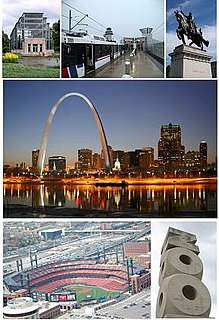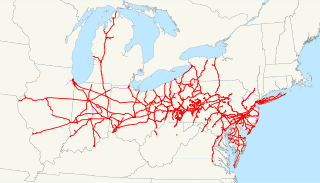| Locale | Indiana Illinois |
|---|---|
| Dates of operation | 1905–1917 |
| Track gauge | 4 ft 8 1⁄2 in (1,435 mm) standard gauge |

The Vandalia Railroad was formed in 1905 by a merger of several lines in Indiana and Illinois including the Terre Haute & Indianapolis Rail Road and the St. Louis, Vandalia & Terre Haute Railroad which covered a route from Indianapolis, Indiana, to St. Louis, Missouri. Another route between Terre Haute, Indiana, and Toledo, was created with the inclusion of the Terre Haute & Logansport and Logansport & Toledo branches. [1]

Indianapolis, often shortened to Indy, is the state capital and most populous city of the U.S. state of Indiana and the seat of Marion County. According to 2017 estimates from the U.S. Census Bureau, the consolidated population of Indianapolis and Marion County was 872,680. The "balance" population, which excludes semi-autonomous municipalities in Marion County, was 863,002. It is the 16th most populous city in the U.S. The Indianapolis metropolitan area is the 34th most populous metropolitan statistical area in the U.S., with 2,028,614 residents. Its combined statistical area ranks 27th, with a population of 2,411,086. Indianapolis covers 368 square miles (950 km2), making it the 16th largest city by land area in the U.S.

St. Louis is an independent city and major inland port in the U.S. state of Missouri. It is situated along the western bank of the Mississippi River, which marks Missouri's border with Illinois. The Missouri River merges with the Mississippi River just north of the city. These two rivers combined form the fourth longest river system in the world. The city had an estimated 2017 population of 308,626 and is the cultural and economic center of the St. Louis metropolitan area, which is the largest metropolitan area in Missouri, the second-largest in Illinois, and the 22nd-largest in the United States.

Missouri is a state in the Midwestern United States. With over six million residents, it is the 18th-most populous state of the Union. The largest urban areas are St. Louis, Kansas City, Springfield, and Columbia; the capital is Jefferson City. The state is the 21st-most extensive in area. In the South are the Ozarks, a forested highland, providing timber, minerals, and recreation. The Missouri River, after which the state is named, flows through the center of the state into the Mississippi River, which makes up Missouri's eastern border.
Contents
In 1917 the line was acquired by the Pittsburgh, Cincinnati, Chicago and St. Louis Railroad giving the Pennsylvania Railroad a direct route from New York City to St. Louis. In 1968 PRR merged with NYC to become Penn Central and in 1976 becoming part of Conrail. Much of the North-South line was abandoned with the Conrail formation but parts of the East-West line survive as part of CSX Transportation.

The Pittsburgh, Cincinnati, Chicago and St. Louis Railroad, commonly called the Pan Handle Route, was a railroad that was part of the Pennsylvania Railroad system. Its common name came from its main line, which began at Pittsburgh, Pennsylvania, crossed the Northern Panhandle of West Virginia, and continued west to Bradford, Ohio, where it split into a northern line to Chicago and a southern one through Indianapolis, Indiana, to East St. Louis, Illinois.

The Pennsylvania Railroad was an American Class I railroad that was established in 1846 and was headquartered in Philadelphia, Pennsylvania. It was so named because it was established in the Commonwealth of Pennsylvania.

The City of New York, usually called either New York City (NYC) or simply New York (NY), is the most populous city in the United States. With an estimated 2017 population of 8,622,698 distributed over a land area of about 302.6 square miles (784 km2), New York is also the most densely populated major city in the United States. Located at the southern tip of the state of New York, the city is the center of the New York metropolitan area, the largest metropolitan area in the world by urban landmass and one of the world's most populous megacities, with an estimated 20,320,876 people in its 2017 Metropolitan Statistical Area and 23,876,155 residents in its Combined Statistical Area. A global power city, New York City has been described as the cultural, financial, and media capital of the world, and exerts a significant impact upon commerce, entertainment, research, technology, education, politics, tourism, art, fashion, and sports. The city's fast pace has inspired the term New York minute. Home to the headquarters of the United Nations, New York is an important center for international diplomacy.









